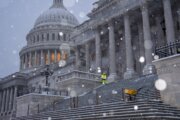Editor’s Note: WTOP reporter Dave Dildine is now safe and back in D.C.
He returned earlier this week. He agreed to write a column about his
experience.
WASHINGTON — Twelve hours into the snowstorm, there was no longer the
ability to walk or stroll — only to flail, for what it was worth. An
incredible lake-induced snowscape enveloped a swath of Western New York
earlier this week. More than five to six inches of snow fell for hours on end
inside the narrow squall. The Lake Effect Snow Machine was in overdrive with
its sights set on denizens of Buffalo, New York.
Last weekend, when forecasters began calling for an “incredible lake effect
snow event,” I decided I wanted to be a part of weather history. On Monday
afternoon, my flight from Reagan National Airport to Buffalo Niagara
International Airport would fly through the cold front that, hours earlier,
had escorted a frigid air mass across the Great Lakes. The record-setting cold
set the stage for a localized, but epic, snowstorm.
Moisture-laden clouds were coalescing into a great band of snow as I drove
through downtown Buffalo later that evening. I came prepared with a first aid
kit, layers of clothing, hand warmers, backup batteries and a week’s worth of
non-perishable food and water. Within the first few hours of snowfall it
became apparent, however, that driving was unsafe. I resisted the temptation
to explore further. I checked into a hotel. Hours later, travel would be
impossible.
The storm’s overnight exhibition was extraordinary. As the winds increased, so
too did the size of the drifts. And then, in a flash, came the thundersnow —
a half-dozen strokes of lightning in succession at close range. The crack of
thunder was deafening, not at all diminished by the onslaught of snow.
Next to the hotel, traffic on the New York State Thruway ground to a halt by
midnight. Drivers in vehicles of all sizes became stranded, overwhelmed by
merciless snowfall. Cars, pickups and semis were left abandoned in the middle
of roads nearby, catawampus and clustered. They were soon shrouded in snow,
frozen in time.

Snow drifts over an abandoned car on a once-plowed Route 75. The lake effect storm left thousands of drivers stranded. (WTOP/Dave Dildine)
By the following morning, visibility was often near zero. My periodic walks
became more exhausting as the snow depths increased. It was impossible to
venture more than a hundred feet or so from the hotel without fear of becoming
disoriented and lost.
Back at the hotel, the white walls were closing in. Enormous “snow dunes”
swelled upward from the parking lot to the second-story balcony. The windows
and walls were rimmed in clumps of ice.
South of Buffalo,
shoveling is futile today. pic.twitter.com/HlQW3llOqd
— Dave
Dildine (@DildineWTOP) November 18,
2014
That night, the roof of the hotel creaked and moaned under the weight of the
snow. This made for a tense, restless sleep. The storm’s howling winds were
now deadened by enormous drifts that banked up against the walls.
By dawn, the squall had lifted north and weakened. The sun rose over a
glaciated landscape. Most human things had vanished; the edges of cars were
erased. Houses and larger structures appeared lower, their roofs blunted
by sagging cornices made of ice. Vehicles abandoned on the nearby roads were
nearly invisible.
With skies already darkening by midday and another several feet forecast, a
hectic and exhausting dig-out ensued. In the narrow window of clear
weather, I was faced with a labyrinth of road closures between the hotel and
airport. A 20-minute drive to Blasdell (south of Buffalo) was a
nearly four-hour return trip, with many roads, including the New York
State Thruway, closed or impassable. I arrived at the airport as the next
round of snow was moving overhead.
I learned that every city has its breaking point. In Washington, a mere inch
of snow during rush hour will cause the grid to seize. But five to six feet of
snow in 24 hours, even in the snow-savvy suburbs of Buffalo, is crippling and
downright dangerous.
Follow @WTOP on Twitter and WTOP on Facebook.







